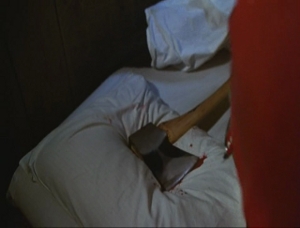
In the beginning, there was Alfred Hitchcock. And Alfred said, “Let there be Psycho.” And there was Psycho, coupled with widespread rejoicing.
Among those who rejoiced one young man stood among them somewhere in the vicinity of the Getty Museum. He alone in all the world possessed the strength and skill to answer Hitchcock’s Psycho and move its story forward, almost exactly twenty years later, into an age where Norman Bateses seemed to suddenly fill the land (or, at the very least, the land’s primary news outlets). His name was John Carpenter. He said, “Let there be Halloween.” And there was Halloween, coupled with widespread rejoicing.
It’s strange to come back to Crystal Lake now that I have some reason to be there. For better or worse (mostly worse, as we’ll see) Friday the 13th remains one of the most influential films of the twentieth century. As a reformed fan of the films that are ostensibly Friday’s children as much (if not more so) than they are Halloween’s, my fingers rebel at typing this phrase…but all those Christian moralizers who spent the 1980s bitching about Slasher movies were right in so far as they likened these films to more…traditional…pornography.
Both forms of entertainment fetishize the familiar, resounding with the repetitive pleasure of gratification that could only be more assured if you found a complementary “Get to Watch Teenagers Fuck and Die” card tucked into your presidential pardon. As with so much else, William S. Burroughs suggested a reason for this back in that 1968:
“Not in innocence and not in Asia was mankind born. The home of our fathers was the African highland on a sky-swept savannah glowing with menace. The most significant of all our gifts was the legacy bequeathed us by our immediate forebears: a race of terrestrial, flesh-eating killer apes . . .
Own up to it, because once the Apocalypse hurries up and gets here, you’ll be toting around a shotgun just like the rest of us. Especially in the event of zombies.
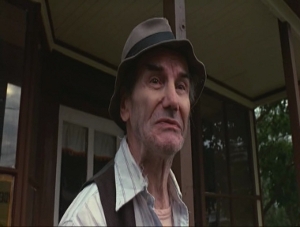
As a terrestrial killer ape, there’s a perverse part of my reptile brain that finds “fun” in stories centered around the suffering of my fellow humans, insomuch as I have no emotional attachment whatsoever to the subjects of those stories. All the better, then, if those subjects are totally fictional, poorly written…and acted…directed…just poor…people. The poorer the better because then we know we are deep in the land of the low budget horror movie, where the real reason for Friday the 13th‘s otherwise-inexplicable success becomes clear: cheapness. Who needs stars when blood and tits still put butts in the seats? Every movie producer since Edison has that tattooed on the inside their eyelids. And no one has it printed in bolder, more-ostentatious type than producer/director Sean Cunnigham.
Having helped Wes Craven make the only decent rape-revenge film ever, Last House on the Left, Cunningham watched Halloween make a wide-eyed, film school geek (and his wife) into independent-movie magnates and experienced a vision. Casting about for a way to reproduce their success while simultaneously avoiding their lawsuits, Cunningham combined John Carpenter’s shit-happens sensibilities with the exploitative, gore-drenched strum an drum of European horror movies – especially the films of Mario Brava. Especially 1971’s Twitch of the Death Nerve.
Welcome, then, to Camp Crystal Lake. It’s 1958 and the counselors sing Hallelujah, blissfully unaware of the Evil POV camera stalking through the night. Barry (Willie Adams) and Claudette (Debra S. Hayes) (the guitar player – but it’s okay – she wasn’t doing that good a job of fake-playing anyway) break off to have sex in an adjacent barn. The Evil POV camera interrupts them, stabs the boy, and menaces the girl until we cut to title. You’ll notice none of the cast receives any credit up front.

Flash to “Friday, June 13th, The Present, [that is, 1980, one assumes]” and Annie (Robbi Morgan), who’s transported herself deep into Rural America…somehow…but lacks the teleportation power to make it the last twenty miles to Camp Crystal Lake, where she’s netted a job as cook. Local trucker Enos (Rex Everhart) agrees to haul her out but on the way to the truck both are waylaid by crazy local color Crazy Ralph (Walt Gorney). “You’ll never come back,” Crazy Ralph says. Crystal Lake, or “Camp Blood,” has apparently got itself “a Death Curse.” All who go there are, in one of the most immortal lines of 1980s cinema, “doomed. DOOMED!”
On the way up, Enos outlines the practical implications of this, giving Annie (and us) some well-intentioned advice: “Quit. Camp Crystal Lake is jinxed…two kids murdered in ’58, boy drowning in ’57. Bunch of fires. Nobody knows who did any of it.” Annie refuses this advice…though God only knows why, and it’s unfortunate the script neglects to give her a reason. She’s just “got to” sling hash for a bunch of ungrateful midgets. If I were in her boots I’d have long-since said “Fuck this” and flashed my tits at the first driver heading in the opposite direction. (Yes, not a woman alive would make that joke. Hey, at least it didn’t involve menstruation.)
Cut to a red pick-up occupied by Ned (Mark Nelson), Marcie (Jeannine Taylor) and Jack (Kevin Bacon), pursued by some of the country-bestest banjo music this side of a He-Haw reunion. At camp, they find Camp Blood’s new owner, Steve (Peter Brouwer), and the only one who seems to be getting any work done, Alice (Adrienne King).
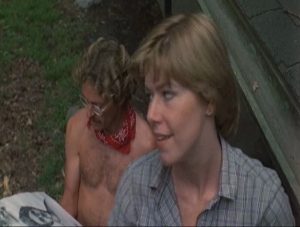
After our banjo-backed trio departs to “change” we watch Steve peek at Alice’s sketchbook while she tacks up a gutter. “Do I really look like this?” Steve asks. “You did last night,” Alice retorts, a phrase pregnant with widespread implications for the entire Slasher sub-genre. Don’t pause to consider that. You might blink and miss Alice’s one moment of characterization. She “may have to go back to California to straighten something out.” Steve asks for “another chance. Stay another week. Help get the place ready.” Alice agrees, despite Steve’s unfortunate penchant for stroking his employee’s hair by way of saying thanks. (Does everyone in this film have a case of the grabbies?)
What does Alice have to “straighten out” in California? Fuck if I know. It’s never mentioned again.
As with Halloween, it’s difficult to see Friday the 13th as it was originally meant to be seen. Not as the progenitor of a sub-genre’s worth of tropes but as a bullshit Murder Mystery centered around a bunch of camp counselors and their slightly older boss…who’s folks, we learned from Enos, wound up “crazy and broke.” When Steve departs for town in a green Jeep (with its top down), promising to be back before lunch, we’re meant to use this is as evidence, suspecting him in every gratuitous stalk-and-slash scene that follows.
Speaking of which, there’s Annie, still blithely hitching her way toward Doom. A green Jeep (with its top up) stops and she climbs aboard. Too late, Annie realizes she’s riding with the Evil POV cam, and thus also riding with Death. Jumping from the car, Annie sustains the Obligatory Leg Wound and lurches, Karloff-like, into the woods, only prolonging the inevitable. Bye, Annie. Sorry to see you go first, but it was pretty obvious you would. And my ex-girlfriend wants you backpack.

Twenty minutes in, you begin to notice the unfortunate (and intentional) similarities between Harry Manfredini’s score (which announces every “shock” the same way laugh tracks announce sitcom “jokes”) and Jaws. It’s atonal, distracting, and its absence seriously undermines every fake scare in the film…that is, the vast majority of them. Carpenter’s Halloween theme, repetitive and ill-timed though it may have been, saved itself through it’s distinctiveness…much like the film as a whole, now that I think about it…It wasn’t a warmed over rip-off of John Williams jacked up on a weekend’s worth of speed that somehow managed to gain a reputation as “the greatest horror sound track ever.”
Never mind. Time to meet the last of our cannon knife fodder: Bill (Harry Crosby) and Brenda (Laurie Bartram). Already the Major Arcana of the Slasher Movie Character Tarot Deck are apparent: Manly Spice (Jack), Serious Spice (Alice), Odious Comic Relief Spice (Ned), Adventurous Spice (Brenda – who suggests the game of “Strip Monopoly”), A Girl (Marcie) and A Guy (Bill).
But let’s pause to consider Kevin Bacon’s exit. It’s preceded by the one actually effective moment so far: Marcie’s “shower dream” scene. Here, Jeannine Taylor really sells a haunting personal confession to a seemingly nonplussed Jack. They have sex on the bunk beds of a nearby cabin to wash the taste of this human moment out of their mouths, never noticing Ned’s dead body laying prone in the bed above them. Marcie leaves to pee. Jack lights a post-coital smoke and an unseen hand seizes his head while a arrow’s driven through his neck from below.

Consider: The Killer arranged Ned’s body and, hearing Jack and Marcie coming over the Ominous Thunderstorm, hid under the lower bunk. The Killer waited while they had sex (those must be some sturdy springs on those bunks) and killed Jack only after the evening’s entertainment concluded. I know people were desperate for porn before the internet arrived, but…sweet Jesus.
Jack’s murder, like the shot of Steve leaving, also cheats the audience with its misdirections, painting a false picture of our killer as a highly organized predator, a mind under exceptional amounts of control. Not the kind of mind to murder a whole campful in one go. This is not some out-of-control sadist reenacting a past trauma, or a soul-less, opportunistic spree killer out to slaughter promiscuity. Ah, but later…
Wait – Marcie just died as I typed that. Axe to the face, in obvious homage to Twitch of the Death Nerve. Not that anyone knew at the time. Other than Sean Cunnigham. And make-up man Tom Savini, who I’ll admit does great work here. I know it’s been “surpassed,” since by sheer technical innovation, but that axe to the face will always be number one in my heart.
Back to Strip Monopoly. Brenda uses the storm as an excuse to go to bed, but doesn’t take her clothes with her. She dies tastefully off screen. We flash to Steve, who’s seemingly spent his whole day away in the town diner…or has he? With his Jeep stalled by the torrential rain, Steven gets a lift back to camp from the sheriff…only to encounter the Evil POV cam.
By this point, Alice and Bill are getting rather nervous. The disappearance of everyone else, the bloody axe they find in Brenda’s bed, and the sudden failure of the camp generator all conspire to lead Bill out into the night…after he’s violated Randy Meek’s Third Rule of Horror Movies and told Alice, “I’ll be right back.”
At this point, the Campbellian skeleton supporting every Slasher movie’s back end (because Joseph Campbell was nothing if not all about the ass) becomes apparent. Alice receives her

Call to Adventure in the form of a dream, waking from it with Bill’s name suggestively on her lips. She

Refuses the Call by attempting to make coffee. As the camera focuses in on her, she realizes the fruitlessness of waiting around like some damn mannequin to be saved. Giving up, Alice
Crosses the Threshold into the haunted night, oblivious to the fact she’s now a founding member of the Final Girl Sisterhood. She gets a view of Bill’s corpse nailed to a door marked “Danger,” with that subtle, Cunningham touch, and thus enters
 The Belly of the Beast. To the dulcet tones of my cheering, Alice runs back to her cabin and constructs a barricade out of whatever’s at hand…only to tear it down seconds later when she believes the
The Belly of the Beast. To the dulcet tones of my cheering, Alice runs back to her cabin and constructs a barricade out of whatever’s at hand…only to tear it down seconds later when she believes the
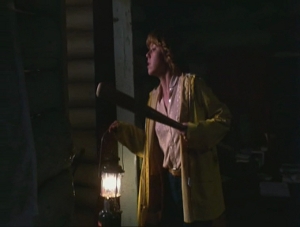
Supernatural Aide’s here, in the form of a green Jeep. With its top up. She thinks it’s Steve’s but, oh shiz-nit, it’s Alice’s
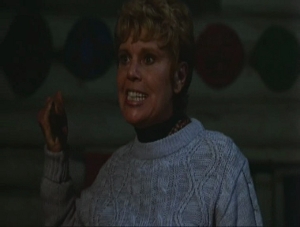 Nadir, Mrs. Voorhees “an old friend of the Christys” who happened to have Annie’s job on that faithful day in 1957…when her boy, Jason, drowned in the lake. “You see, Jason was my son. And today is his birthday…Oh, I couldn’t let them open this place again, could I? Not after what happened.”
Nadir, Mrs. Voorhees “an old friend of the Christys” who happened to have Annie’s job on that faithful day in 1957…when her boy, Jason, drowned in the lake. “You see, Jason was my son. And today is his birthday…Oh, I couldn’t let them open this place again, could I? Not after what happened.”
Here’s where the film not only defies my careful outline, it jumps the shark. They’ll be no Fatherly Intervention here. It’s up to Alice, all by her lonesome, to overcome Mrs. Voorhees’ peculiar definition of motherhood. A definition we’ve not heard a goddamn thing about ’til now.
Still, on one level, it’s a heck of a story. Youthful speed and vigor triumphs over post-menopausal madness in yet another display of our cultural obsession with all things under a certain age but over a legally proscribed one. That, at least, I can get behind. We have to get the old people before they get us, you know? Still, it’s a big cheat because Friday the 13th sells itself as a “Who’s doing it?” mystery and then throws in a new character right at the climax, making every emotional investment we’ve made up until this point wasted energy.
Let me just surface from the sea of bile a moment to say that I rather liked the inversion of Psycho inherent in Mrs. Voorhees as a character. Okay, back down we go, like 2000 flushes.
Poorly acted, “written” in the sense that words were inscribed on its script pages with ink, semi-capably directed, peppered with good special effects shots that linger just long enough and the occasional laugh-out-loud moment of Bad, Friday the 13th is arguably the best in its series, required viewing for that alone. It’s not good, it’s not pretty, it’s not well-made, but it was (and is) influential, and I wouldn’t be doing my father (the History Major) justice if I didn’t yield to that.
What it inspired is another matter. We’ll have nine ten eleven more opportunities to discuss that in this series alone. Tom Savini apparently came up with the idea of throwing a reanimated Jason in at the end because he’d just seen Carrie. And “we thought that we need a ‘chair jumper’ like that and I said, ‘let’s bring in Jason.'” Meaning the rest of the Friday sequels really, truly, are all his fault.
Thanks, Tom. Thanks a whole hell of a lot.
![]()
![]()
Oh, yes. The whole Virginal Final Girl thing is bullshit. Alice is just as happy to join in on the drinking, pot smoking, and Strip Monopoly as everybody else in her cabin. She even puts up an arguably better fight than Jamie Lee Curtis once things get down to brass tacks…despite a terminal case of some degenerative nerve disease that makes her drop every single weapon she picks up once she’s used it. I think we can safely label this Laurie Strode Syndrome and continue on to Part 2: The One Without the Subtitle…after I once again urge you to look at that smile on her face in the screen caps. “You did last night,” indeed. That’s literally what she said.

Another great review. I enjoy the style of writing to this website and neat catch on the fact it was originally a murder mystery.
We try our best. Especially when we’re out to “catch” the obvious.
I have since subjected to myself to the joyous and dubious pleasures of the AMC Friday the Thirteenth marathon. Which, I point out, leaves out both “A New Blood” and “Jason vs. Freddy” less there be too much GOOD in the franchise. It did, however, do the remake and I was curious if you would be doing a review of that particular misstep in the franchise–game effort as it was.
You know, after turtle time.